The motherboard serves as the central nervous system of any modern computer, dictating everything from component compatibility to overall system performance and potential for future upgrades. The introduction of DDR5 memory marked a significant leap forward, offering higher bandwidth and greater efficiency than its DDR4 predecessor. For those building or upgrading a PC, selecting the right DDR5 motherboard is a critical first step.
While newer chipsets like Intel’s Z790 and B760 series are now prevalent, the initial wave of DDR5-compatible motherboards, particularly those with the Z690 and B660 chipsets, remain relevant. These boards, originally launched for Intel’s 12th Generation processors, can often be updated via a simple BIOS flash to support 13th and even 14th Generation CPUs. This can present a significant value proposition for builders seeking high-end features without the premium cost of the very latest models. Understanding when you should upgrade your motherboard involves weighing these factors of performance, compatibility, and cost.
This technical guide provides an objective analysis of several key DDR5 motherboards, examining their specifications and performance capabilities to help you make an informed decision for your next build.
Comparative Analysis of Leading DDR5 Motherboards
Before diving into individual reviews, a direct comparison of specifications offers a clear overview of what each board provides. This table highlights the essential data points that differentiate these models.
Key Specifications Table
| Feature | MSI PRO Z690-A WiFi | ASUS ROG Strix Z690-E Gaming WiFi | GIGABYTE Z690 AORUS PRO | MSI MAG B660M Mortar WiFi | Biostar Z690 Valkyrie |
| Chipset | Intel Z690 | Intel Z690 | Intel Z690 | Intel B660 | Intel Z690 |
| CPU Socket | LGA 1700 | LGA 1700 | LGA 1700 | LGA 1700 | LGA 1700 |
| Form Factor | ATX | ATX | ATX | Micro-ATX | ATX |
| VRM Power Stages | 14+1+1 | 18+1 | 16+1+2 | 12+1+1 | 20-Phase |
| Max RAM Support | 128GB DDR5-6400+ (OC) | 128GB DDR5-6400+ (OC) | 128GB DDR5-6200 (OC) | 128GB DDR5-6200 (OC) | 128GB DDR5-6000+ (OC) |
| PCIe 5.0 x16 Slot | 1 | 1 | 1 | 0 (1x PCIe 4.0) | 2 (x8/x8) |
| M.2 Slots | 1x Gen4, 3x Gen4 | 3x Gen4 (+2 via card) | 4x Gen4 | 2x Gen4 | 4x Gen4 |
| Wi-Fi | Wi-Fi 6E | Wi-Fi 6E | Wi-Fi 6 | Wi-Fi 6E | Wi-Fi 6E |
| Ethernet | Intel 2.5Gb | Intel 2.5Gb | Intel 2.5Gb | Intel 2.5Gb | Intel 2.5Gb |
| Rear USB-C Port | 1x USB 3.2 Gen 2×2 | 1x USB 3.2 Gen 2×2 | 1x USB 3.2 Gen 2×2 | 1x USB 3.2 Gen 2×2 | 1x USB 3.2 Gen 2×2 |
In-Depth Technical Reviews of DDR5 Motherboards
An effective motherboard does more than just host components; it ensures they operate in a stable, efficient environment. The following analyses explore the technical nuances of each model. A good motherboard for gaming will excel in power delivery, thermal management, and connectivity.
MSI PRO Z690-A WiFi
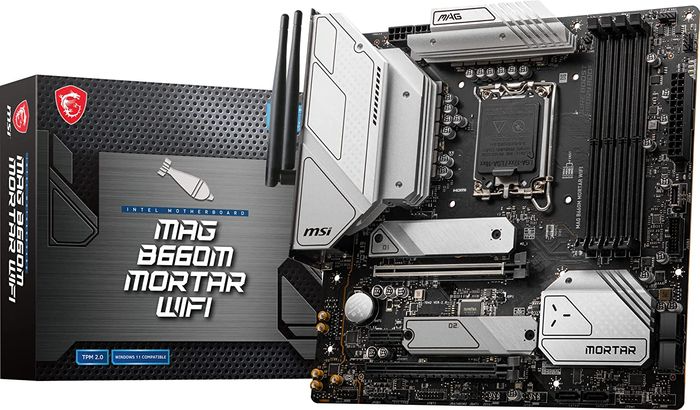
Core Specifications
- Chipset: Intel Z690
- Form Factor: ATX
- Power Delivery: 14+1+1 Duet Rail Power System
- Memory: 4x DDR5 DIMMs, up to 6400+ MHz (OC)
- Expansion: 1x PCIe 5.0 x16, 1x PCIe 3.0 x16, 4x M.2 slots
Power Delivery and Performance
The MSI PRO Z690-A features a robust 14+1+1 power delivery system, which is more than sufficient for reliably running even high-end Intel Core i7 and i9 processors. Its Core Boost technology ensures precise and stable current delivery to the CPU. The board’s 6-layer PCB with 2oz thickened copper contributes to better signal integrity and thermal performance, which is crucial for system stability during demanding tasks.
Expansion and Connectivity
This motherboard provides a forward-looking feature set with one PCIe 5.0 x16 slot, ready for next-generation graphics cards. Its storage capabilities are substantial, offering four M.2 slots. For networking, it includes an Intel 2.5G LAN port and the latest Wi-Fi 6E standard, delivering fast and low-latency connections for both wired and wireless setups.
Market Perspective
The MSI PRO Z690-A remains a highly practical choice. It delivers the core benefits of the Z690 platform—CPU overclocking and a PCIe 5.0 slot—at a competitive price point. For builders who need a full-featured ATX board without the aesthetic premiums of gaming-centric lines, this model offers exceptional value, provided a BIOS update is performed for the latest CPUs.
ASUS ROG Strix Z690-E Gaming WiFi
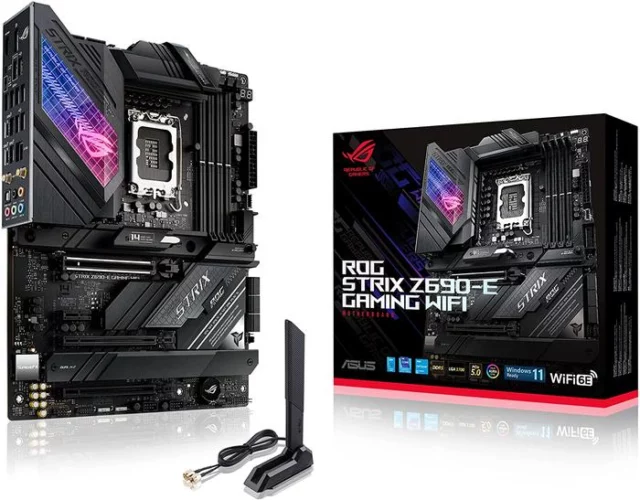
Core Specifications
- Chipset: Intel Z690
- Form Factor: ATX
- Power Delivery: 18+1 Power Stages (90A)
- Memory: 4x DDR5 DIMMs, up to 6400+ MHz (OC)
- Expansion: 1x PCIe 5.0 x16, 5x M.2 slots (with included Hyper M.2 card)
Power Delivery and Performance
Part of the esteemed Republic of Gamers (ROG) line, the Strix Z690-E is engineered for high performance. Its 18+1 power stage VRM is designed to handle extreme overclocking, providing stable power to the most demanding CPUs. The board incorporates extensive heatsinks, including on the VRMs, chipset, and M.2 slots, ensuring components remain cool under load.
Expansion and Connectivity
This board is a connectivity powerhouse. It features a PCIe 5.0 x16 slot and an impressive five total M.2 slots, making it ideal for users with extensive storage needs. The rear I/O is packed with ports, including a high-speed USB 3.2 Gen 2×2 Type-C port. Networking is top-tier, with Intel 2.5 Gb Ethernet and Wi-Fi 6E. ASUS also includes its Q-Latch M.2 system and PCIe Slot Q-Release button, simplifying the build process.
Market Perspective
For enthusiasts and high-end gamers, the ROG Strix Z690-E is still a formidable option. While its Z790 successor exists, this board offers a nearly identical premium feature set. If found at a lower price, it provides a pathway to an elite-tier build with robust power delivery, extensive storage, and user-friendly features.
GIGABYTE Z690 AORUS PRO
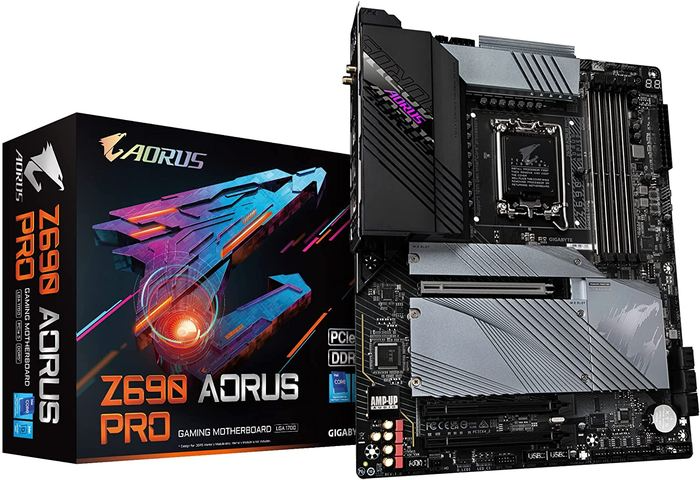
Core Specifications
- Chipset: Intel Z690
- Form Factor: ATX
- Power Delivery: 16+1+2 Twin Hybrid VRM Design
- Memory: 4x DDR5 DIMMs, up to 6200 MHz (OC)
- Expansion: 1x PCIe 5.0 x16, 4x M.2 Gen4 slots
Power Delivery and Performance
The Z690 AORUS PRO utilizes a 16+1+2 twin hybrid digital VRM design, delivering clean and efficient power for high-core-count processors. GIGABYTE’s thermal architecture is a key feature, with large, fully covered heatsinks and direct-touch heatpipes to effectively dissipate heat from the power stages.
Expansion and Connectivity
This board is well-balanced, providing a PCIe 5.0 x16 slot for the primary GPU and four PCIe 4.0 M.2 slots, each with its own Thermal Guard heatsink. This answers the common question of “how many M.2 slots on motherboard” are needed for a high-performance system. It also features Intel 2.5GbE LAN and Wi-Fi 6, ensuring fast networking capabilities.
Market Perspective
The AORUS PRO strikes an excellent balance between performance, features, and price. It is a strong competitor to other mid-to-high-end Z690 boards, offering a powerful VRM and comprehensive thermal solution. It’s a suitable choice for gamers and content creators who want a stable, cool-running system with plenty of fast storage options.
MSI MAG B660M Mortar WiFi
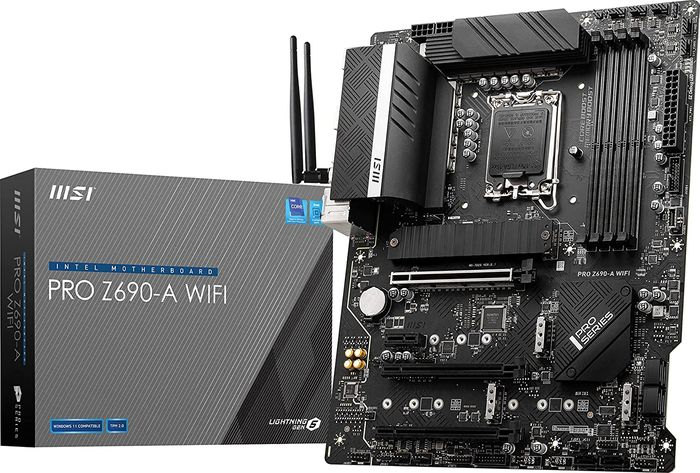
Core Specifications
- Chipset: Intel B660
- Form Factor: Micro-ATX
- Power Delivery: 12+1+1 Duet Rail Power System
- Memory: 4x DDR5 DIMMs, up to 6200 MHz (OC)
- Expansion: 1x PCIe 4.0 x16, 2x M.2 Gen4 slots
Power Delivery and Performance
The B660M Mortar is built around the Intel B660 chipset, which means it does not support CPU overclocking but does support memory overclocking. Its 12+1+1 VRM design is remarkably strong for a B-series board and can comfortably handle high-end, non-K series CPUs like the Core i7-14700. The extended heatsink design provides excellent thermal management for the power components.
Expansion and Connectivity
As a Micro-ATX vs Mini-ITX vs ATX board, the Mortar is designed for more compact builds. It lacks a PCIe 5.0 slot, opting for a PCIe 4.0 x16 slot instead. This is a practical trade-off, as current GPUs do not fully saturate the bandwidth of PCIe 4.0. It includes two M.2 Gen4 slots, 2.5G LAN, and Wi-Fi 6E, offering modern connectivity in a smaller package.
Market Perspective
This motherboard is an outstanding choice for budget-conscious builders who want to leverage DDR5 memory without the expense of a Z-series chipset. It is perfect for high-performance gaming builds using locked (non-K) Intel CPUs. Its combination of a strong VRM, fast networking, and DDR5 support makes it one of the most compelling Micro-ATX options available.
Biostar Z690 Valkyrie
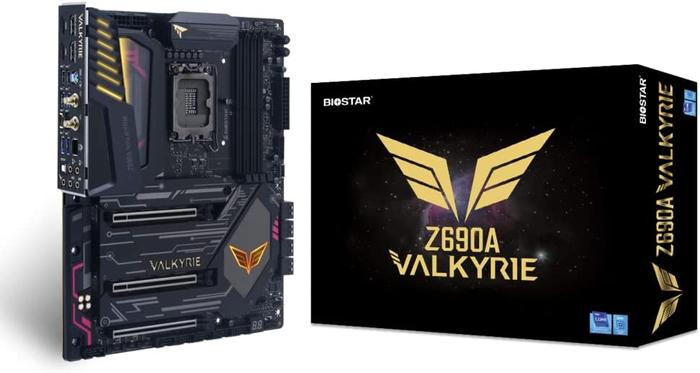
Core Specifications
- Chipset: Intel Z690
- Form Factor: ATX
- Power Delivery: 20-Phase Power Design
- Memory: 4x DDR5 DIMMs, up to 6000+ MHz (OC)
- Expansion: 2x PCIe 5.0 x16 (run at x8/x8), 4x M.2 Gen4 slots
Power Delivery and Performance
The Biostar Z690 Valkyrie is an enthusiast-grade motherboard with a heavy focus on power delivery. Its massive 20-phase VRM is designed for extreme stability under the heaviest loads, making it suitable for competitive overclockers. The entire board is covered in “armor gear,” which acts as a large heatsink to improve thermal dissipation across all critical components.
Expansion and Connectivity
A standout feature of the Valkyrie is its inclusion of two PCIe 5.0 x16 slots. When both are populated, they operate in an x8/x8 configuration, a rare feature that offers flexibility for future multi-GPU or high-bandwidth expansion cards. It also includes four M.2 slots, 2.5GbE LAN, and a slot for a Wi-Fi 6E module.
Market Perspective
The Z690 Valkyrie targets a niche audience of hardware enthusiasts who require maximum power stability and dual PCIe 5.0 slots. While Biostar is a less common brand than its competitors, the Valkyrie provides a unique and powerful feature set. For users planning to push their hardware to its absolute limits, this board is a worthy contender.
Key Factors in Choosing a DDR5 Motherboard: A Buyer’s Guide
Navigating the world of motherboards requires understanding some key terminology and technology.
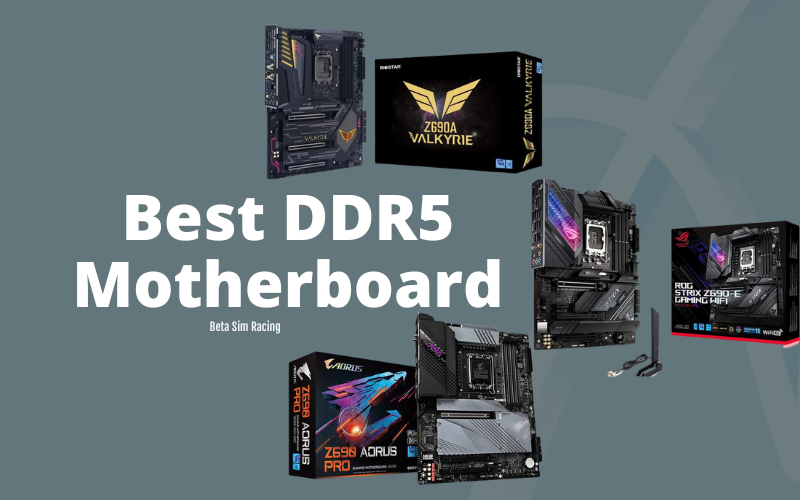
Platform and Chipset: Intel vs. AMD
Your choice of CPU—either Intel or AMD—is the first decision that will dictate your motherboard options. For the latest CPUs, Intel uses the LGA 1700 and LGA 1851 sockets, while AMD uses the AM5 socket. The chipset’s function is to manage data flow between the CPU, RAM, and peripherals. For Intel, Z-series chipsets (Z690, Z790) support CPU overclocking, while B-series (B660, B760) and H-series do not.
CPU Socket: The Foundation of Your Build
The CPU socket is the physical interface where the processor is installed. It is non-negotiable; the motherboard’s socket must match the CPU you intend to use. All the motherboards reviewed here use the LGA 1700 socket, compatible with Intel’s 12th, 13th, and 14th generation CPUs (though a BIOS update is typically required for the newer generations).
Form Factor Explained: ATX vs. Micro-ATX vs. Mini-ITX
The form factor determines the motherboard’s physical size and, consequently, the number of expansion slots it can have and the size of the PC case it will fit into.
- ATX: The standard size for most desktop PCs, offering a good balance of expansion slots and features.
- Micro-ATX: Shorter than ATX, with fewer PCIe slots. A great option for compact, yet powerful builds.
- Mini-ITX: The smallest standard form factor, designed for space-saving builds, typically with only one PCIe slot.
VRM and Power Delivery: Why Stability Matters
The Voltage Regulator Module (VRM) is a critical component that converts the 12V power from your PSU into the precise, lower voltage your CPU needs. A more robust VRM with more power stages and better cooling ensures a stable power supply, which is essential for the performance and longevity of high-end CPUs, especially when overclocking.
PCIe 5.0 for GPUs and Storage
PCI Express (PCIe) is the high-speed interface used for graphics cards and other expansion cards. PCIe 5.0 offers double the bandwidth of PCIe 4.0. While current graphics cards do not yet see a major performance uplift from PCIe 5.0, choosing a motherboard with a PCIe 5.0 x16 slot is a good way to future-proof your system. The standard is also being adopted for ultra-fast M.2 SSDs.
Storage Options: M.2 Slots and SATA Ports
Modern systems rely heavily on M.2 NVMe SSDs for fast boot times and application loading. Consider how many M.2 slots you need. Most modern boards offer at least two, with high-end models providing four or more. SATA ports are still useful for connecting older 2.5-inch SSDs and high-capacity hard drives.
Essential Connectivity: Wi-Fi, Ethernet, and USB
Ensure the motherboard has the connectivity you need. Wi-Fi 6E is the current high-end standard, offering access to the less-congested 6 GHz band. A 2.5Gb Ethernet port is now standard on most mid-range and higher boards, providing faster-than-gigabit wired speeds. Check the quantity and type of rear USB ports to ensure you have enough for all your peripherals.
Frequently Asked Questions (FAQ)
What motherboards support DDR5?
Motherboards designed for Intel’s 12th generation (and newer) CPUs with 600- and 700-series chipsets (e.g., Z690, B660, Z790, B760) are available in DDR5 variants. For AMD, all motherboards using the AM5 socket (e.g., X670, B650) exclusively support DDR5.
Can you use DDR4 RAM in a DDR5 slot?
No. DDR4 and DDR5 memory modules are physically and electrically incompatible. The keying notch on the modules is in a different position to prevent incorrect installation. You must use DDR5 RAM with a DDR5 motherboard.
Does the AMD Ryzen 7000 series support DDR5?
Yes. The entire AMD Ryzen 7000 series (and the newer 8000G and 9000 series) exclusively uses the AM5 socket and requires DDR5 memory.
Is a Z690 motherboard still a good choice?
A Z690 motherboard can be an excellent choice. It offers the core features of modern platforms, including PCIe 5.0 and DDR5 support. With a BIOS update, it can run the latest Intel CPUs, often at a significantly lower cost than its Z790 counterpart, making it a high-value option.
How important is a BIOS update for motherboard compatibility?
A BIOS update is crucial when using a newer CPU on an older motherboard chipset (e.g., a 14th Gen Intel CPU on a Z690 board). Without the update, the motherboard may not recognize the CPU, and the system will fail to boot. Always check the manufacturer’s CPU support list and update the BIOS to the recommended version.

Holding a Ph.D. in Computer Science, Dr. Alistair Finch is our chief PC Component Benchmark Analyst. He provides meticulous, data-driven analysis of CPUs and GPUs, moving beyond marketing claims to reveal their true performance. His guides help readers understand the intricate relationship between hardware architecture and real-world gaming frame rates.
